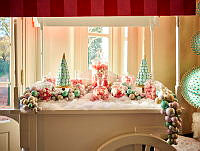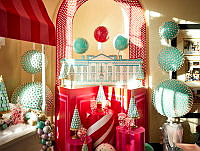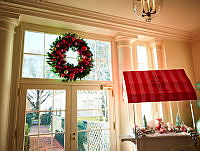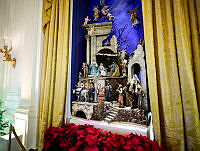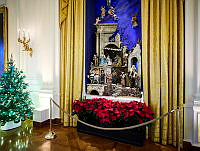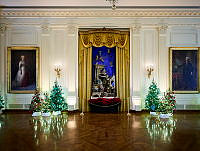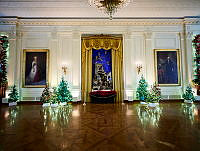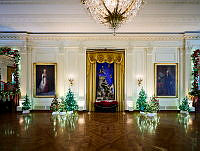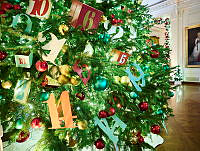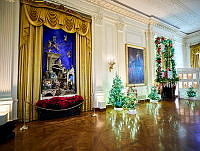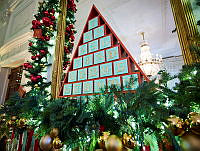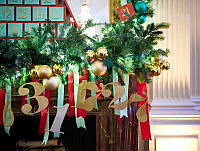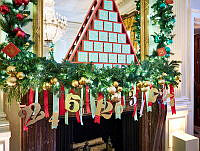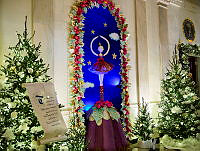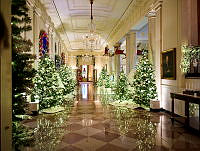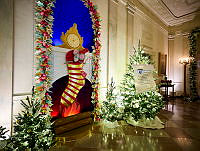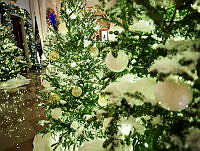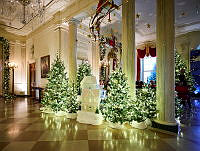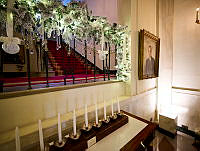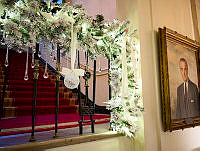Rubenstein Center Scholarship
Harper’s Weekly Invites Its Readers Inside the White House
Historians have previously discussed the wider impact of technological innovations that facilitated the emergence of the illustrated press in the mid-nineteenth century.1 Founded in 1857, Harper’s Weekly offered its readers not only the opportunity to read about the news but also visually bear witness to it for the next six decades. It covered politics, society, and war, as great scholarly attention to Harper’s illustrations of the Civil War has demonstrated. Yet it also published popular stories meant to entertain. Articles dedicated to both intelligence and diversion made the periodical a popular choice. During the Civil War, Harper’s gained a wide readership, and by the end of 1861 its circulation reached 120,000.2 These numbers continued to grow after the war, and by 1872 the publication maintained an audience of 160,000.3 These readers, who came from a wide range of socioeconomic backgrounds, participated in a phenomenon that has frequently been referred to as armchair tourism.4 Armchair tourism broke down the boundaries between the affluent and the working class, allowing those who could not afford luxury travel and the tradition of the grand tour the opportunity to learn about far-away lands. In keeping with the emergence of the figure of the flaneur in the era, other media designed to provide similar vicarious experiences developed simultaneously to the popular press. Just as nineteenth-century Americans might have opened an issue of Harper’s to see scenes of India, they might also have purchased stereographic views to “travel” to exotic locales.
Harper’s not only opened up the world to middle class Americans but also provided an entry to exclusive environments within the United States. Many Americans did not have access to the White House and the ability to experience its interiors. Because of its affordability, the illustrated press’s coverage of events in the White House might have served as their first introduction to the spaces the president inhabited. This essay will discuss the common subjects of Harper’s articles that featured images of the White House, the photographers and draftsmen responsible for them, the accuracy of the depictions, and instances in which information can be rediscovered from these archival sources.
The subjects of these illustrations and features and the frequency with which they appear suggest what kinds of stories held popular interest in the public’s imagination. They were diverse, ranging from receptions—including annual convenings, diplomatic visits, Inaugurations, weddings, and funerals—to daily working life in the house and executive offices. By far the most frequent were images of gatherings, which suggests the periodical’s readers had a greater appetite for coverage of society events than political ones. Although less frequent than features on White House festivities, the periodical’s reports of renovation and expansion efforts also gave readers the best opportunity to appreciate White House interiors. In these instances, illustrations would be accompanied by text describing the changes to room layouts and furnishings.

At this reception, women climbed atop furniture in the East Room to gain a better view of the Japanese delegation, as can be seen by the figures at the left. Artists were present at the event to sketch and record their enthusiasm.
Hathitrust, Harper's WeeklyNot all depictions of the White House prioritized fidelity to the building and its design. Instead, some showed generic interiors. The illustrations of special occasions typically captured scenes in either the State Dining Room or the East Room. Given the frequency with which these spaces were depicted, it would have been easy for artists located elsewhere to recreate the spaces without travelling to Washington and witnessing the events in person. Furthermore, these scenes were often crowded with figures who either turned their back to the viewer or lacked distinctive features, becoming indistinguishable and serving as staffage. Despite the generic nature of some of these depictions, they are sometimes differentiable by the activities occurring in them which oftentimes corresponded to the article’s text. In one image from an 1860 article showing a Japanese embassy visiting Washington, women stood on chairs and other furniture in order to gain a better perspective on the goings-on (above).5 The article described the circumstances further, recounting how the “limited furniture of the East Room was seized and used to elevate the ladies. The elegant rosewood chairs and sofas, the pride of rural Americans, were wheeled from their positions against the wall, and converted into platforms for distinguished American ladies of fashion and beauty. One of the chairs accommodated three ladies and a senator in this manner. Even the marble slabs under the mirrors were not overlooked, and one pretty lady rendered herself conspicuous by setting herself in a looking-glass with an elegant frame.” This description, and the accompanying illustration that showed three women balanced above the crowd, would have enlivened the furnishings of the East Room in readers’ imaginations.
Although images could be generic, some were strikingly accurate. The author of the aforementioned 1860 article describing a visit by a Japanese delegation recounted how artists were present at the reception, sketching the East Room. Sometimes, the caption makes an explicit claim of authenticity, like in 1885, when a caption for a portrait of President Chester Arthur at his desk was appended with “drawn from life by Frederic Dielman.”6 In this instance, Harper’s attribution was likely motivated by Deilman’s stature as a painter, but the practice of completing preparatory sketches from life extended beyond Dielman.7 Several of Harper’s illustrators had a reputation for sketching from life, perhaps none more so than Theodore R. Davis, who had begun his career with the periodical during the Civil War when he traveled to battlefields. His experiences recording the dynamic events for the news later resulted in his article, “How a Battle Is Sketched.”8 Before the war, Davis had been Harper’s artist-correspondent in Washington.9 After the war, in the late 1860s and early 1870s, Davis represented the White House interiors for the periodical, and he later gained even greater access to the space when working on designs for the Rutherford B. Hayes State Service.

This illustration of the White House stables was based upon a photograph by Lewis Emory Walker, the chief photographer of the Treasury Department at the time, and is the first image of the White House in Harper’s to explicitly credit a photograph as its source.
Hathitrust, Harper's WeeklyIn other instances, illustrations completed in New York or elsewhere by more accomplished artists might have been based upon preparatory material produced in Washington by others, including those not employed by Harper’s. The first caption to credit a photograph of the White House was part of an article from 1869 dedicated to the Executive Mansion’s stables (above).10 It cited the work of Lewis Emory Walker who served as the chief photographer of the Treasury Department from 1857 to 1880, documenting federal construction projects.11 For readers, this attribution would have differentiated the drawing from a mere generic, illustrative impression of a stable, and it would have leant greater significance to the smaller, more precise details the illustrator chose to include.
One article invested greater interest in the process by which a photograph was taken than the subject it depicted. Here, the practice of taking a photo became newsworthy.12 As in the example of the Harper’s illustration of the White House stables, the publication was again reliant upon a network of artists outside of its staff in order to produce an accurate illustration. This 1879 illustration of a cabinet meeting was based upon an image taken by the New York City photographic firm, the Pach Brothers (below).13 The article glorified the photographer who, after observing the meeting, was permitted to take an image of President Rutherford B. Hayes and his cabinet. While the author celebrated the photograph as a record of a room and an event, he also proposed it served as a kind of portrait, recalling the Pach Brothers’ main focus on portrait photography. The captions, which identified each of the figures by name, makes the level of detail the photograph afforded for the illustrator explicit. The illustration also included detailed representation of key pieces of furniture and other decorations, such as the walnut conference table that had been specially designed for the room so that it held eight locked drawers, one for each cabinet member.14 Despite the increasingly faint level of detail in the illustration as the room receded, a map of the country was visible on the wall in the far corner of the room. At the same time as the image lends us insight today about this meeting room in a specific historical moment, the photograph was not a necessary innovation in order to make such accuracy and transparency in reporting possible. An earlier 1869 depiction of the room in Harper’s from the Ulysses S. Grant administration shows how many of these details were translated without a photographic aid.15

President Rutherford B. Hayes granted a photographer from the firm, the Pach Brothers, permission to capture a cabinet meeting. Harper’s translated the photograph to an illustration and reported on the photographer’s success.
Hathitrust, Harper's WeeklyEventually advances in reproductive printing allowed for the inclusion of photographs alongside text in newsprint. Photographs of the White House began appearing in Harper’s in 1893, likely showing the interiors from Benjamin Harrison’s presidency.16 This first spread showed the White House’s presidential bedroom and office, the library, and the nursery (below). Such photographs offered readers access into the private quarters that members of the public would not have been able to witness at the time.

These photographs gave readers exclusive access to the private quarters of the White House during Benjamin Harrison’s presidency.
Hathitrust, Harper's WeeklyThe Harrisons had granted the illustrated press an inside look before, as demonstrated in a Harper’s article published the previous year in recognition of First Lady Caroline Harrison’s funeral.17 Accompanying illustrations had not only included representations of scenes from the funeral but also reused illustrations that had likely been created before her death, including a portrait of the deceased and a view of her sitting room (below).

At her death, First Lady Caroline Harrison was commemorated not only through images of her funeral but also through her sitting room at the White House.
Hathitrust, Harper's WeeklyEven though, by 1893, it was possible to print photographs in the periodical, the majority of the images of the White House continued to be traditional illustrations, appealing to readers’ nostalgia and making a claim for the publication’s more artistic identity. After the turn of the century, as photographs became increasingly common, their copyright frequently betrayed their source, as was the case in a spread in 1902 on the newly renovated Executive Mansion under Theodore Roosevelt (below).18 Like his predecessor Benjamin Harrison, President Roosevelt placed his bedroom on view for the public by means of a published photograph. The image is attributed not to a Harper’s employee or a commercial photographer but rather the official White House photographer, Barnett McFee Clinedinst. At this point, when the White House began to produce its own imagery and Harper’s was no longer reliant upon its illustrators’ hands, the periodical shifted away from offering its readers a unique visual perspective of the space.

These images of the private quarters of President Theodore Roosevelt were taken by an official White House photographer: Barnett McFee Clinedinst.
Hathitrust, Harper's WeeklyBefore the inclusion of photographs in Harper’s, White House renovations had been rendered by hand, as in 1883, when the artist Charles Graham illustrated a redecoration of the home carried out by Louis Comfort Tiffany and the Associated Artists in a sketchy, almost impressionistic style (below).19 His technique was suited to his subject; both Graham and Tiffany and the Associated Artists’ were part of the aesthetic movement. But ultimately, his looser approach to the drawings would have made it challenging for readers to fully grasp the details of the renovation, such as those of the new, stained-glass screen in the Entrance Hall.

While the impressionistic style of these illustrations suited the aesthetic of Louis Comfort Tiffany and the Associated Artists, who had recently redecorated the White House, it is difficult to fully appreciate the details of the renovation given their sketchy nature.
Hathitrust, Harper's WeeklyInstead, in 1906, in article by Glenn Brown, the Secretary of the American Institute of Architects, Harper’s captured the work of the architectural firm McKim, Mead & White with photographs.20 Brown was deeply invested in the question of how architecture might represent national identity, and he authored several books on the subject, including a history of the U.S. Capitol and a memoir, subtitled “A Winning Crusade to Revive George Washington’s Vision of the Capital City.” 21 Additionally, he contributed to the establishment of the U.S. Commission of Fine Arts and promoted the L’Enfant plan, which served as the basis for the McMillan plan.22 In fact, Brown’s expertise in the Colonial Revival and preference for neoclassical taste allowed him to serve as the historical adviser and construction superintendent for McKim, Mead & White’s undertaking at the White House. Brown made no announcement of his connection to the project in his article for Harper’s. Despite this, the piece was intensely personal. Brown used exaggerated prose to render harsh judgements about previous redesigns and refurbishing of the White House, which he described occurring during a dark age in art history, and to celebrate a return to Neoclassical Style in the 1906 effort. His article was complemented by a series of photographs that showed four public spaces on the State Floor—the Entrance Hall, the Blue Room, the State Dining Room, and the East Room—both before and after the renovation (below). In the captions for these images, he compared the rooms resulting from Tiffany and the Associated Artists’ work in 1882 to “the bar of some popular restaurant,” a “better class board-house parlor,” and “an over-ornamented saloon loaded down with crude decorations and inharmonious colors” while he used terms like “dignified,” “harmonious,” and “stately” to describe McKim, Mead & White’s designs. Here, despite the use of more reliable photographs, Harper’s employed text to frame the images and continue to offer a distinct interpretation of the White House interiors. Although Brown bluntly discussed his strong opinions, the impartiality of the photographs allowed readers to perform their own evaluations about the success of the renovation.

This article is laid out so readers can compare before-and-after images of the White House’s renovation by McKim, Mead & White. This spread reveals the transformation of the entrance hall.
Hathitrust, Harper's WeeklyWhile Harper’s articles served an undeniable purpose in their day, acquainting average Americans with the interiors of the White House, the archival preservation of these issues also aids today’s historians. Many issues referenced specific objects, including lesser-known curiosities. One of the most remarkable accounts related the story of the “Rejected Stone” (below).23 As the 1869 entry described, the United States had been gifted a stone from the tomb of Servius Tullius in 1865, inscribed in honor of Abraham Lincoln. The gift had been inspired by the commonalities between the two leaders—both had risen from humble origins to positions of leadership, both were brave defenders of liberty, and both were murdered while fighting for their causes, becoming martyrs afterwards. At the time of its publication, the Harper’s article covered the rediscovery of the stone four years after its arrival in the United States, and after it had been placed in several marginal positions, including on the porch, as a footstool in front of a White House window, and eventually in the basement “on a heap of rubbish.” While the Harper’s article announced the stone’s new, worthy placement in the Capitol Rotunda, it did not remain there for long. By 1870, Representative Shelby Cullom of Illinois had the stone transferred to Springfield, where Lincoln’s tomb was being constructed.24 Today, the stone remains ensconced in the tomb, set into the base of Larkin Mead’s sculpture of Standing Lincoln. Without such an article in Harper’s, the stone’s presence in the White House could easily have been lost to history.

This “Rejected Stone” was taken from the tomb of Servius Tullius and given by Italy to the White House in honor of President Abraham Lincoln. Although it failed to find a proper home in the White House, it was incorporated into Lincoln’s tomb in Springfield, Illinois.
Hathitrust, Harper's WeeklyHarper’s Weekly ignited the imagination of common Americans with its stories that catered to popular interests and its extensive illustrations that transported readers to another place. Its coverage of events at the White House gave citizens access to a privileged interior and a stake in diplomatic happenings. The popularity of articles dedicated to celebrations and social events suggests Americans were especially interested in the White House as a space of entertainment. The periodical catered to this investment in spectacle with its illustrations that might have altered details for a desired effect. At the same time, the text frequently cited both illustrators and photographers and their working process in order to establish the images’ authenticity. Today, the journal serves to suggest how the average American of the past might have envisioned the White House and its spaces.
About the Author
Olivia Armandroff is a Ph.D. student in the Department of Art History at the University of Southern California. She works on twentieth-century American art, with research interests that include imagery through printed materials, the subversion and renegotiation of social boundaries through visual media, and questions of space and the built environment. She holds a B.A. in the History of Art and History from Yale University, where she studied early-twentieth-century fashion for individualized bookplates. She also earned an M.A. in American Material Culture from the Winterthur Program, writing a thesis about the artists who were a part of the early-twentieth-century New York salon of Muriel Draper.













